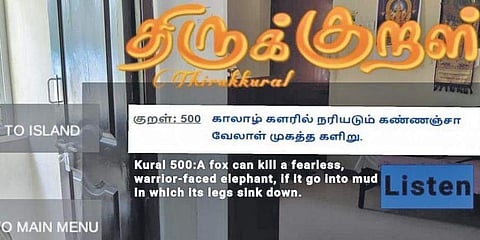

It’s been approximately 2,000 years since it was first created, over two centuries since the first known printed edition was published, and a little over 180 years since it was printed in the English language for global consumption. The Thirukkural, an ancient Tamil literary work addressing myriad themes by poet-philosopher Thiruvalluvar has, over the centuries, transcended time and technologies.
From being on old palm manuscripts to now finding an important place in the digital repositories of renowned scholars and students alike, the body of work continues to dominate the literary world across languages and cultures. But how does one make the consumption of the 1,330 kurals (couplets), the values and virtues it has to offer, more immersive? “Augmented reality (AR),” say Nauvyashree Anbarasan and Pavithra Paneerselvam, students of Information Science and Technology from Anna University’s College of Engineering, Guindy, who’ve integrated the ancient teachings of the work into an extended reality format and named it, Thiruvalluvar.
“As part of third-year semester projects, we had to work on something creative and innovative. So, while discussing possible ideas with my mother, who has earlier done a few projects on Tamil literature, the idea to integrate extended reality and e-learning with Thirukkural brewed. With the couplets being compact, we thought it would be the perfect fit for this,” shares Nauvya.
Interpretation in images
In the creation process, the duo was challenged with limitations, especially when they were posed with the task of classifying the kurals to make them edible for virtual consumption. “The Thirukkural is already classified into three parts — aram, porul and inbam. However, for our project, a prototype, to make the process seamless, we decided to delve into how Thiruvalluvar was a keen nature lover, an observer, and grouped the kurals based on nature themes — animals, birds and other elements.
Since the couplets follow a specific grammatical structure and classical form of poetry called the venba, wherein each kural has only two lines, we could integrate it into AR,” explains Pavithra, adding that the incompatibility of developing softwares, primarily gaming softwares with Tamil fonts too had to be navigated. “We had to process individual images instead of keying in Tamil text. It was a laborious process.”
A peek into the prototype, we are immediately transported to the wilderness. We see flora, fauna and interesting natural elements dotting its interface. Click the buttons above the three-dimensional models, and a screen with couplets relevant to the image or module pops up. Click another button and a voiceover of the kural booms, making the learning experience all the more interesting.
In the virtual world
The idea was to look beyond the traditional methods of learning which often include static text and images. “During our research on immersive e-learning, we hardly found any reference to Tamil literature. This dearth is one of the reasons why we decided to head in this direction. It took us almost three months to create this prototype. Use of AR in Tamil literature will create more awareness about the rich works we possess, in this case, allow users to visualise the couplets, make the learning process more interesting and perhaps, increase long-term memory retention,” she details.
Bridging the gap between the real and virtual world through AR in the Tamil literature context, the duo is now hoping to further their work into a larger community initiative. “We are planning to move this for our final project and in the process, bring in different AR modules — portals, panels, storylines etc., to make it more immersive. If we have the access to VR developing software, we would also like to explore that world,” shares Pavithra.
Going places
The duo’s ThiruvalluvAR project was selected among 300 department projects for a tech exhibition. “Here, we got to meet many industry experts and professors who appreciated our efforts and told us that it was a unique idea especially to classify the Thirukkural based on the biomes and to integrate it into Augmented Reality,” beams Nauvya, pointing to the opportunities that have come their way in the last few months.
“We also interacted with the brain behind Footprints_DM, a social media initiative that hopes to make the dream of Thirukkural through AR a reality. This led us to participate in a Club House event filled with enthusiasts of the aphoristic teachings. Many were interested in our work and offered to contribute to it. Now, we are thinking of uploading the codes and the back-end into a public repository, so that it can be accessed by people who want to create and develop this further. This way, it will make way for a community project that realises this dream of Thiruvalluvar AR to its full potential,” shares Nauvya.
Immersed in reality
We see flora, fauna and interesting natural elements dotting its interface. Click the buttons above the 3D models, and a screen with couplets relevant to the image or module pops up. Click another button and a voiceover of the kural booms, making the experience interesting.
